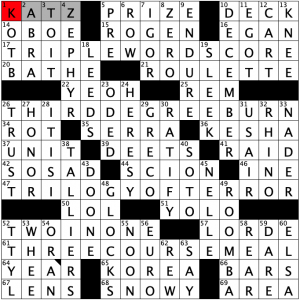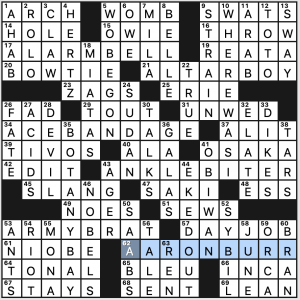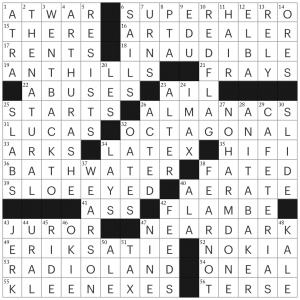Daniel Larsen and The Wave Learning Festival Crossword Class’s New York Times crossword—Jenni’s review
This is a very cool debut. The Wave Learning Festival in their own words “has a commitment to lessen the educational inequities caused by the COVID-19 pandemic, as well as the long-standing gaps in educational opportunity.” Daniel Larsen applied to offer a crossword constructing class to middle- and high-schoolers. He explains over at Wordplay that the puzzle he constructed with the first class was rejected by the Times. He offered the class a second time and this is the result. Sounds like a terrific program and a great experience for the kids!
It’s a rhyming theme, which gives us a good Monday-level experience.

New York Times solution grid, Daniel Larsen and the Wave Learning Festival Crossword Construction Class, September 21, 2020, #0921
- 17a [Time to watch boxing on TV] is FIGHT NIGHT. This made me think of boxing on TV in the 1950s. Turns out it’s also a UFC thing these days. I can’t think of anything I’m less likely to watch than the UFC, so I didn’t know that.
- 30a [One rushing in to save the day] is a WHITE KNIGHT.
- 47a [It makes your pupils constrict] is a BRIGHT LIGHT.
- 64a [“Precisely!”] is QUITE RIGHT.
A solid, consistent, and completely accessible theme. Well done!
A few other things:
- Tony OLIVA was the first DH for the Minnesota Twins. I looked him up and was surprised to realize he’s not in the Hall of Fame. He was Rookie of the Year, won the AL batting title for three seasons, and won a Gold Glove.
- 12d [Paradoxical response to a door knock] is I‘M NOT HERE. Hah.
- 21a [“Hmm, I’m intrigued …”] is a fun clue for OOH.
- I’ll wear my LEI out on the LANAI.
- We get [Enthusiastic] twice, for KEEN and EAGER.
What I didn’t know before I did this puzzle: see above re: the UFC FIGHT NIGHT.
David Distenfeld’s Los Angeles Times crossword — Stella’s write-up

Los Angeles Times 9/21/20 by David Distenfeld
Good things come in threes in this puzzle, except when they come in fours. Every theme entry has something to do with threes:
- 17A [Red bonus square on the Scrabble board] is a TRIPLE WORD SCORE.
- 26A [Serious injury for a firefighter] is a THIRD-DEGREE BURN.
- 47A [1975 made-for-TV horror anthology starring Karen Black] is TRILOGY OF TERROR. (Hmm, interesting! Rotten Tomatoes’ Tomatometer rating is 92%, although audiences rated it much lower.)
- 61A [Appetizer-entree-dessert serving] is a THREE-COURSE MEAL.
We’ve got slightly inconsistent execution, which is not my favorite: All of the “three” theme words are at the beginning of the phrase, but TRIPLE, THIRD, and THREE are adjectives and TRILOGY is a noun. I also don’t love THIRD-DEGREE BURN (I’d have tried to pick a theme set that allowed a THIRD phrase with more pleasant connotations, like THIRD-BASE COACH) or TRILOGY OF TERROR, which seems like a pretty deep trivia cut for a Monday. I would have also given extra credit for a revealer instead of a fourth theme entry — not that this theme truly needs a revealer, but why not have three theme phrases if your theme is all about threes? Then there could be a fourth entry like COME IN THREES or something like that.
Let’s move on to the good stuff: I was mightily pleased by the number of women mentioned in this grid. My favorite is the divine Michelle YEOH at 22A (fun fact: that insane emerald ring from Crazy Rich Asians actually belongs to her, and she did not wait for someone else to give it to her). But there’s also the choice to clue EGAN (16A) as the author Jennifer rather than a dude with that name; pop music is represented with KESHA (36A) and LORDE (57A); talk TV with Hoda KOTB (1D); Joan of Arc in the clue for 24D; fictional women Lorna DOONE (43D) and NELLE from Ally McBeal (45D). Plus Karen Black in the clue for the theme entry at 47A.
In sum: Theme could use some work, but the woman-friendly fill makes up for it in my book.
Debbie Ellerin’s Wall Street Journal crossword, “Six-Pack Abs”—Jim P’s review
Theme: Six well-known two-word phrases starting with the initials A.B.
- 17a. [Danger signal] ALARM BELL
- 21a. [Priest’s assistant] ALTAR BOY
- 34a. [Wrapper for a sprained wrist] ACE BANDAGE
- 43a. [Tot, humorously] ANKLE BITER
- 53a. [Kid often on the move] ARMY BRAT
- 62a. [Leslie Odom Jr.’s role in “Hamilton”] AARON BURR. Just noticed this name starts and ends with two pairs of letters. Any famous Lloyds or Llewelyns that have this feature?
Great theme for your new crossword-solving friends, yeah? It features clean and interesting (or even fun) entries accessible to just about anybody.
Plus, there’s plenty of colorful fill, starting with “WHERE WAS I?”, BOTANY BAY (clued as the British penal colony, but we all know it as Khan’s marooned ship from Star Trek II, right?), and Lake WOBEGON (though I never knew it was spelled like that).
On the other hand SAKI [Pen name of short story writer H.H. Munro] and REATA [Ranch in Edna Ferber’s “Giant”] are probably on the tougher side for a Monday. And probably NIOBE [Weepy woman of myth] as well. But the crossings are fair enough.
Simple theme, but well executed 3.4 stars.
Patrick Berry’s New Yorker crossword – Rachel’s writeup
Good morning, starshines! It’s the last day of summer, and supposedly it’s 38 degrees outside in Syracuse right now. Let’s talk crosswords!
This was a weird solve for me because I knew it was supposed to be a challenging puzzle, and it was full of excellent ? clues, but it felt like I figured out the trick right away with almost all of them, so I came in right around/just under my average moderately challenging puzzle time. Some of the best ? clues included:
- [One involved in moving pictures?] for ART DEALER
- [Restaurants with no waiting?] for CAFETERIAS
- [Colonial housing?] for ANTHILLS
- [Light desserts, e.g.?] for FLAMBÉ
The long entries are also mostly pretty fun: NO HARM DONE, KLEENEXES, OCTAGONAL are all great, and I appreciated seeing ANITA BAKER and a (fully-named!) ARTHUR ASHE as well (not to mention a fully-named ERIK SATIE! Patrick Berry is really leaning in to teaching us about the people whose names are sometimes reduced to their possession of convenient letters). I’m personally not so sure about RADIOLAND. which is probably a thing, but old-timey slang is beyond my wheelhouse. I bought and studied several ALMANACS when I was studying for Jeopardy, and now I don’t know what to do with them. If you’re in the market for a paper record of 2018 or 2019, let me know, I guess?
A few more things:
- Can we just acknowledge how weird and hilarious [Having pitch-black, pulchritudinous peepers] is as a clue??? (for SLOE-EYED)
- Surprised to see the terrible fill ATRA at 1-Down from a Patrick Berry puzzle! The rest of the fill is solid
- Representation: we have baseball and ballet and “old-timey slang,” but also several people of color. I know I ask this every time, but isn’t OKIE an offensive term? I would love a definitive answer on this so I can stop flinching every time I see it in a puzzle!
- I was *obsessed* with the musical HAIR for several years of my life and still go back to the original soundtrack when I’m having a bad day.
Overall, plenty of stars for this solid, mostly-entertaining. delightfully ?-filled, not-exactly challenging Patrick Berry puzzle! See you on Wednesday.
Jake Halperin’s Universal crossword, “Movement Movement” — pannonica’s write-up

Universal • 9/21/20 • Mon • “Movement Movement” • Halperin • solution • 20200921
Lexeme-level spoonerisms. These are all movements—two predominantly artistic and one primarily political—ending in -ism. Internal parts of these movements have themselves been moved around.
- 20a. [Belief in the superiority of emails over letters?] MODERN-POSTISM (postmodernism). 9d [Transmitted] SENT.
- 36a. [Belief in the superiority of the second-largest continent’s skillets?] AFRICAN PANISM (Pan-Africanism).
- 54a. [Belief in the superiority of the first “Matrix” movie?] CLASSIC NEO-ISM (neoclassicism).
Just three themers, though of 13 letters, which gives the grid room to breathe. And they were mildly entertaining. Can’t ask for much more in a Monday theme.
- 17a/57a [Certain fruit skin] RIND, PEEL.
- 23a [First Latina Disney princess] ELENA of Avalor, which was merely a television series that ran from July 2016 until last month, August 2020.
- 34a [Start of a formal self-introduction] I AM, but I tried the more nebulous MAY, as in “May I introduce myself …”
- 61a [A unicycle has one] AXLE. But it could have been SEAT or WHEL. Anyway, some related content: 21d [Lines in a circle] RADII, 29d [Formed part of a circle] ARCED.
- 62a [Children may roll down them] HILLS. Possibly on a unicycle.
- 7d [Clashing clothing?] ARMOR. Ow.
- 13d [Far from forward] SHY. For a moment, before examining crosses, I thought this would be AFT.
- Favorite clue: 27d [Coastal retreat?] EBB.
- Little bit of a forced connection here, but at least there’s no cross-reference: 38d [Ninja, at times] ASSASSIN, and 49a [Move like a ninja] SNEAK.
- 46d [Cheese in some bagels] ASIAGO. Yeah, why is it always ASIAGO? Also, no thanks.
- 55d [NYC neighborhood with many shops] SOHO. Once upon a time there were practically no shops there at all, just semi-abandoned warehouses and factories, which in turn became lofts for struggling artists. And now? Asiago bagels on every other corner.
bonus:


I don’t think “foamy” is a correct adjective to describe bubble tea
NYT: Nice theme. I did find the SW more difficult than usual for a Monday: I’ve never heard of bubble tea. And I don’t say “train stop”, is that a thing? Here we have tram stops and bus stops, but trains always stop at stations.
Tony Oliva has a good shot at the Hall of Fame when the Veterans’ Committee meets in 2021 (was supposed to be this year, but, ya know). This time around they are specifically considering players whose contributions came between 1950-1969.
TNY, I don’t think of Okie as disparaging. “I’m proud to be an Okie from Muskogee” and all that.
Since it’s Patrick Berry, definitely a fair and, well, nontrivial Monday for a change. I’m sure I’ll find Wednesday much harder. I didn’t recognize Luther and ELBA, but plenty of crossings. Must admit I still don’t understand AERATE, as all I can think of for “tiller” is farming or steering a boat.
Tilling the soil = aerating the soil.
Could it be that tilling the soil aerates it? Just a guess. I haven’t done that puzzle yet, so I haven’t seen the clue.
I have not heard OKIE used in a pejorative or disparaging way. It’s the Stumper answer to 17A (“Garth Brooks, by birth”) which I had to get from the crosses, but seemed more fact-y than critical.
My mother, who was born in Canada (in 1918), taught me that “Canuck” was a pejorative term, but I have seen it lately as a fairly neutral epithet. Since I’m not sure, I avoid using the term.
Does anyone else have a different take?
My understanding (supported by a brief Google search) is that the term originally referred to the Dust Bowl refugees who left Oklahoma (and other places) for Southern California. In that sense, it was disparaging – it implied not only poverty but ignorance and laziness (much the way people living in poverty are still seen by a lot of USers). “I’m Proud To Be An Okie From Muskogee” was a way of reclaiming the term as a point of pride. I don’t know that the term still carries a negative connotation. I haven’t bumped on it in puzzles, although I wouldn’t use it myself.
My mother lived in Canada for one summer during high school and also taught me that “Canuck” was derogatory based on her experience there. It’s the name of a hockey team, though, isn’t it?
It does happen that words refashion themselves, getting more or less acceptable as times change. I suppose “Canuck” is an example of one getting nicer.
I would probably still not use either.
From Wikipedia-
“English Canadians and others use “Canuck” as a mostly affectionate term for any Canadian.”
The name gained much good will from a fictional Canadian hero of the 19th century named Johnny Canuck who was a lumberjack cartoon metaphor for Canada as it reacted to Uncle Sam’s bullying. Johnny Canuck was also revived during World War Two as a Canadian cartoon super hero fighting the Nazis.
And, yes, the NHL team from Vancouver is named the Canucks, inspired by the so named cartoon hero. (It hasn’t helped in their quest for a Stanley Cup as they are one of the two oldest NHL teams never to have won one.)
NYer:
I think that’s just something DJs say. “Hello to everyone out there in Radioland!”
Today’s New Yorker was the hardest Patrick Berry I have ever tried to solve: I failed entirely.
BEQ: Preeeeeeeeetty sure that 8A is not actually the correct pluralization, and multiple light side force wielders are collectively JEDI.
Also I have to admit I ran the alphabet for the 33A/30D crossing and it still took a few seconds for me to realize that “THE NIT HIT ME” isn’t just some cool slang BEQ knows about. Though to be honest, “THE NIT HIT ME” is exactly how I felt after filling in 8A!
Re: New Yorker (specifically, Rachel’s question about 46D):
I’ve been saying for about the last year and change that constructors should avoid OKIE. It may not represent the worst slur one can utter, but it strikes me as classist at best, particularly from people who aren’t from the state (and a ton of published puzzle constructors aren’t). See here from the Oklahoma Historical Society:
In 1937 California passed an “Anti-Okie Law,” making it a misdemeanor to “bring or assist in bringing” any indigent person into that state. The law was later declared unconstitutional, but the bias remained. There are those who, like Will Rogers, believed that the migration of “Okies” to California raised the intellectual level of both states. In many western states “Okie” continues to be used as a derogatory term. In Arizona an “Okie” is a person with “a pee-stained mattress on top of his car,” and an “Okie credit card” is a siphon hose and gas can. In other states an “Okie” is a calf of the lowest quality run through an auction ring.
And from an interview with James Gregory, a labor historian who’s written books about the Dust Bowl and 1930s migration:
“Okie” is a real old term, often used in a friendly way by Oklahomans in decades before the 1930s, and somehow in the 1930s itself, as Californians were looking for ways to depict people who were making them anxious because they were poor and because they were competing for jobs, that term “Okie” became a whole social concept. And it was not just Okie, but there was “Arkie” and “Texie.” So, Okies, Arkies and Texies became terms that were used to define some of these people who were coming into the state as “other,” as “not us.” And the way those terms worked was to almost ethnicize, almost create a notion that an Okie was a different nationality, a different ethnic group, certainly a different social class and an unwelcome person.
…
Ironically, over time, Steinbeck’s book also helped to cement those social categories, helped to create it. It’s possible that if John Steinbeck – and certainly, if John Steinbeck and Woody Guthrie and Dorothea Lange and a few other people hadn’t written and created such memorable portraits, then the Okie phenomenon probably would have faded a lot faster than it did. Art helped to cement what it didn’t invent, what people had invented; but art made it more concrete and permanent; made those images last and last and last.
Full disclosure: I have used the plural form in a puzzle once before, but I’ve stopped using it and I think it’s worth encouraging other constructors to avoid it.
THANK YOU for this extremely thorough answer, this is exactly what I needed.
Very interesting and enlightening discussion, thank you all.